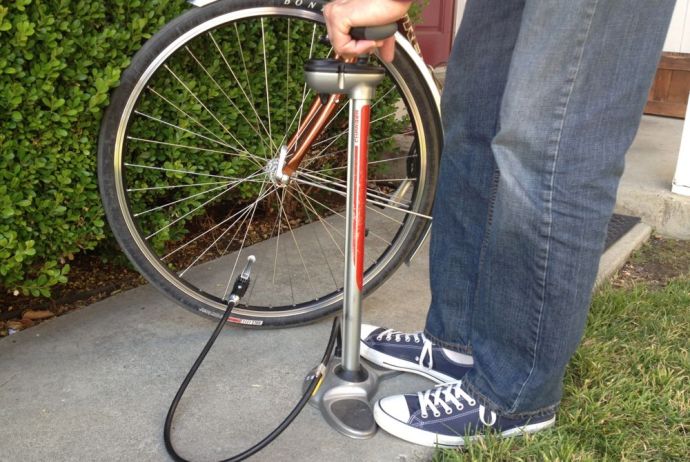This story originally appeared in Bike Fun in the online edition of the Mountain View Voice on May 24, 2013.
Memorial Day is here which means that summer is well on its way. If you haven’t been on your bike in months, it’s time to pull that bike out of the garage or storage closet and get it back into action. But how do you know if it’s ready to roll? It’s as easy as your ABCs.
A = Air. The first, most obvious problem with bikes that haven’t been used in a while is flat tires. Bike tires can lose pressure quickly (especially high pressure skinny tires) but the only way to know if they’ve gone flat from a puncture or just gradually over time is by pumping the tires up, waiting and crossing your fingers. We recommend pumping up your tires and waiting overnight before going off on a ride since a slow leak might not show up right away. If the tires are still inflated and full of air the next day you’re probably good to go.
How much air should you put in? Like automobile tires, bike tires have minimum and maximum air pressures molded into their sidewalls. In general, the skinnier the tire, the higher the pressure. We also recommend a quick visual check of the tire. Even if the tires hold air, if they’re worn out or have slits in the tread, or are dry with cracked sidewalls, they’re likely to fail. Consider replacing them before they leave you stranded.
B = Brakes. The most important safety feature of your bike is its brakes. If you can’t stop quickly and predictable you can’t ride safely. You can check your brakes in three steps. First, lift your front wheel, spin it and squeeze the front brake (usually the left brake lever on your handlebar). Second, lift your rear wheel, spin it and squeeze your rear brake (right brake lever). If squeezing the brakes doesn’t stop the wheel or makes horrible sounds, take your bike to a nearby bike shop.
If your brakes pass the first two steps, take your bike out for a quick road test by riding around the block or around your apartment parking lot. If the bike doesn’t stop well or makes excessive noise you know where to go–your local bike shop. If the brakes aren’t stopping your bike, please walk or drive your bike there. Riding a bike with bad brakes is a surefire way to get hurt.
C = Chain. A bike’s chain is what gives it the power to GO! The quick way to test your chain is to lift the rear wheel and turn the pedals. It may be easier if you have a friend help with this part. If the pedals crank smoothly and the chain doesn’t skip around from gear to gear when you’re not touching the shifters, then take it out for a quick spin to test the front and rear shifting. If your bike is a single-speed or you’re “set it and forget it” when it comes to gears, then you can skip this.
If your chain is rusty or gunky to the point that your chain’s links stiffen up, you may need a good cleaning and re-lubrication to get you back on the road or trail. Stop in at your local bike shop and ask them to show you how to take care of your chain. Chains do stretch and wear out. Don’t be surprised if the shop says your chain needs to be replaced.
The ABCs are just enough to get your bike ready for summer riding. After you’ve been riding a while you may find your bike doesn’t shift easily from one gear to another, you may hear strange noises, or otherwise need a professional to check out what’s going on with your bike. But if your bike passes the ABC test, just go out and ride.
Is your bike ready to go for the summer? What’s the toughest part of keeping it in tip-top shape for you? Do you sometimes long for a new bike? If so, what would it be?











